- PEACE FLAG
- Any one of a number of flags designed to symbolize peace as, for example, those illustrated below (see also
‘rainbow flag’).
![[Peace flag]](../images/v/vxt-d239.gif)
![[Peace flag]](../images/v/vxt-d239a.gif)
![[Peace flag]](../images/v/vxt-d239b.gif)
![[Peace flag]](../images/v/vxt-d239c.gif)
From left: Two variants of the Rainbow Flag; Variant of the
Dove of Peace Flag; Campaign for Nuclear Disarmament (fotw)
- PEAK
- 1) The highest point of the gaff to which the ensign of a warship is shifted
(moved), when it is said to be flying at the peak or at the peak of the gaff – see
‘shift colours’ (also
'ensign'
and 'gaff').
- 2) A colloquial synonym (although technically incorrect) for the top of a
normal flagpole (see ‘truck 1)’ and
‘finial’).
Notes
a) With regard to 1), that the practice
of shifting the ensign became necessary in the sailing era due to the introduction of a lower spar to the
mizzen gaff sail, whilst in modern warships the ensign is shifted from an ensign staff to
the peak of the gaff for reasons of tradition or operational requirement
(see also ‘ensign staff’).
b) Also with regard to 1), that (whilst underway) sailing ships - whether
civilian or naval - still have the option of flying their ensigns from the peak of the gaff if fitted, or from
two-thirds the way up the leech of the mainsail if Bermuda rigged (see also
‘leech’), however, the ensign should always be
returned to a staff at the stern when the vessel is at anchor or berthed alongside.


Ensign At The Peak; Ensign Flown At The Leach
- PENCEL (or PENCIL)
- 1) A term, now obsolete, for a narrow ribbon attached below the head of a
lance or spear (see see also ‘banderole 2)’,
‘banderole 3)’ and
‘lance pennon 1)’).
- 2) See ‘pennoncel’.
- PENDANT
- A largely (but not entirely) obsolete spelling of pennant - see
pennant 2).

Red Commissioning Pendant, England then UK c1630 – 1864 (CS)
Please note, however, that this dictionary uses
the older term first when referring to obsolete designs or patterns of this
type - see ‘budgee pendant’,
‘common pendant’,
‘man o'war pendant’,
‘pendant coupe’,
‘pendant number’ and
‘pendant of distinction’.
- PENDANT COUPE
- In British RN usage now obsolete, an alternative term for what later became known as the code
or answering pennant – see ‘code pennant’ (also
‘pendant’).

Pendant Coupee/Answering Pendant c1920 (fotw)
- PENDANT (or PENNANT) NUMBER
- The term was originally used for the group of signal flags/pennants
unique to an individual naval vessel, and raised to indicate that any
subsequent signal hoist was sent from or was intended for that vessel and for no others,
it is now – as a pennant, registration or hull number - a combination of
letters and numbers that identify a particular vessel within the naval
structure (see also ‘call sign hoist’,
‘make her number’,
‘private signal 3)’ and
‘signal flag’).
- PENDANT (or PENNANT) OF DISTINCTION
- The original 17th/18th Century English/British naval term, now obsolete, for
a commodore’s broad pennant (see also
‘broad pennant’,
‘budgee pendant’ and
‘pendant’).
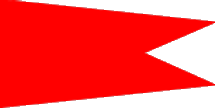
Pendant of Distinction/Broad Pendant 1674 – 1864, England then UK
Please note – not to be confused with the distinction pendant used in Marryat’s code – see
‘distinction pennant’.
- PENDO
- A medieval term, now obsolete, for a pennant or small flag.
- PENNANT
- 1) A general (and imprecise) term for flags which are not strictly rectangular.
- 2) A flag which will usually narrow in width between the
hoist and the fly, and which may be triangular, square-ended or swallow-tailed
(see also ‘flag 2)’,
‘swallow-tail(ed)’ and
‘trapezoid’).
See supplemental note and the notes below.


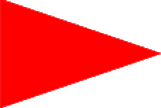
Notes
a) With regard to 2), the following modern flags
can fall into this category: broad pennant,
burgee,
pincel,
club pennant,
command pennant,
guidon,
lance flag,
masthead pennant and others, as do obsolete
(or increasingly obsolete) forms such as
cornet, pavon,
pennon and pensel, and it is strongly suggested that the
more precise terms (as defined separately herein) are to be preferred in description.
b) One common denominator,
which distinguishes a pennant from a flag (as defined in ‘flag 2)’
as referenced above), is that the former is usually secondary
to the latter, and differs from it in shape, size and/or in the manner of display.
- PENNANT OF COMMAND
- See ‘masthead pennant 1)’.

Pennant of Command/Kommandowimpel of Germany (Wikipedia)
Please note that this term is a translation of the
German kommadowimpel, and should not be confused with a command pennant as
separately defined herein.
- PENNON
- 1) See ‘fanion 2)’.
- 2) See ‘lance pennon 1)’ and
‘badge pennon’.
- 3) In official Scottish usage, a 120 cm long pennant that is either triangular in form or has a rounded point,
and which may be granted by Lord Lyon King of Arms to any armigerous person who applies – but see
‘guidon 3)’ (also
‘armigerous’, ‘badge pennon’ and
‘pinsel’).
- 4) At sea, an increasingly obsolete term for a small pennant.
- PENNONE
- An obsolete spelling of pennon – see ‘lance pennon 1)’.
- PENNONCEL (PENNONCELLE, PENICELLUS or PENNUNCELLUS)
- 1) Generically the term, now obsolete, for any small flag (usually)
carried on a lance – a pencel – but see ‘badge pennon’
and 2) below (also
'badge in heraldry',
'livery colours',
and
‘lance pennon 1)’).
2) Specifically the term, now obsolete, for an armigerous swallow-tailed lance pennon –
see ‘pennoncier’.
- PENNONCIER
- The medieval term, now obsolete, for a knight who bore an armigerous,
swallow-tailed pennon on his lance and was, therefore, below the rank
of banneret – a knight bachelor – see ‘pennoncel 2)’ (also
‘armigerous’,
‘badge pennon’,
‘banneret 2)’ and
‘lance pennon 1)’.

Lance Pennon of a Pennoncier (or Knight Bachelor), England 1415
- PENSIL
- See ‘pinsel’.

Pensil/Pinsel of the Clan Fraser (Fraserchief)
- PENTAGRAM
- A hollow five-sided (star-like) figure - but see ‘Magen David’ and its following note.

Flag of Giebenach, Switzerland (fotw)
- PER BEND
- 1) In heraldry the term used when a shield, a banner of arms or any
quartering thereof is divided
diagonally from top left to bottom right across its field (see also
‘banner of arms’, ‘bend’,
‘in bend’, ‘party’ and
‘quartering 1)’).
2) In vexillology the term is sometimes used in place of in bend or bendwise when an object,
charge or charges are placed as above (see also ‘armigerous’,
‘descending diagonal 2)’,
‘bicolour 1)’ and
‘crown of rue’).


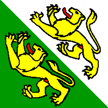
House Flag of BosKalis NV, The Netherlands (fotw); National Arms of
Bosnia-Herzegovina (fotw); Flag of Thurgau, Switzerland (fotw)
- PER BEND SINISTER
- 1) In heraldry the term used when a shield, a banner of arms or any quartering thereof
is divided diagonally from bottom left to top right across its field (see also
‘banner of arms’, ‘bend sinister’,
’in bend sinister’,
‘party’ and
‘quartering 1)’).
- 2) In vexillology the term is sometimes used in place of in bend sinister or bendwise
sinister when an object, charge or charges are placed as above - but see
‘ascending diagonal 2)’
(also ‘bicolour 1)’).


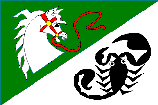
Flag of the Anarcho-Feminists, Germany (fotw);
Arms and Flag of Nehodív, Czech Republic (fotw)
- PER CHEVRON
- The heraldic term used when the divisions on a shield or banner of arms, or a series of charges thereon,
appear to form a triangle, sometimes embowed and generally (although not invariably) with the apex upward –
but see ‘pile 1)’ and ‘pile 2)’
plus the following note (also ‘banner of arms’, ‘chapé’,
‘chevron 2)’,
‘embowed’,
‘party’ and
‘reversed 2)’).




Flag of Alberton, South Africa (fotw); Flag of Neu Wulmstorf, Germany (fotw); Arms and Flag of Koprivnica-Krizevci,
Croatia (fotw).
Please note that the difference between a shield or a banner of arms that is divided “per chevron”
and one showing a “pile reversed” is not always clear, and it is suggested that the note following
‘per pile’ and a glossary or dictionary of heraldry be consulted for further details.
- PER CHEVRON EMBOWED (ARCHED or ENARCHED)
- See per chevron,

Flag of Seftigen, Switzerland (fotw)
- PER COMPLEMENT
- See ‘moon 2)’ with following note.
- PER FESS
- 1) In heraldry the term used when a shield, a banner of arms or any
quartering thereof is divided
horizontally (see also ‘banner of arms’, ‘fess’,
‘in fess’,
party and
‘quartering 1)’).
- 2) In vexillology the term is sometimes also used in place of in fess or fesswise when
an object, charge or charges, appear in a horizontal position.


Flag of Medalpad, Sweden (fotw); Arms of Recica ob Savinji, Croatia (fotw)
- PER PALE
- 1) In heraldry the term used when a shield, a banner of arms or any
quartering thereof is divided
vertically (see also ‘banner of arms’, ‘in pale’,
‘pale’, ‘party’
and ‘quartering 1)’).
- 2) In vexillology the term is sometimes also used in place of in pale or palewise when an object,
charge or charges, appear in a vertical position.


Flag of Aargau, Switzerland (fotw); Flag of
West Flanders, Belgium (fotw)
- PER PALL
- In heraldry the term used when the division lines on a shield, banner of arms or flag are arranged in the form a pall – see
‘in pall’ and
‘pall 2)’.
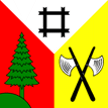
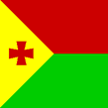
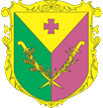
Flag of Fenin-Vilars-Saules, Switzerland (fotw); Flag and Arms of
Olexandria, Ukraine (fotw
- PER PILE
- See ‘pile 2)’ and the following note.


Flag of Stockholm lan, Sweden (fotw); Arms of
Werdohl, Germany (fotw)
Please note that this term should always be used with a further description, for example,
“tierced (or party) per pile reversed” or “tierced/party per pile reversed embowed” –
see ‘embowed’,
‘party’,
‘per chevron’ with its following note,
‘reversed 2)’ and
‘tiercé’.
- PER SALTIRE
- 1) In heraldry the term used when the division lines on a shield, banner
of arms or flag run in a diagonal fashion from the upper corners - saltirewise
- but see note below
(also ‘banner of arms’, ‘in saltire’,
‘party’, and
‘saltire’).
- 2) In vexillology the term is sometimes also used in place of in saltire or saltirewise
when two separate objects or charges cross each other diagonally - but see
note below (also
‘orthogonal’ and
‘quartered diagonally’).
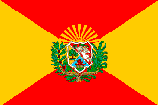
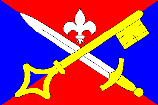
Flag of Aragua, Venezuela (fotw); Flag of Lubenice, Czech Republic (fotw)
Please note with that the standard vexillological term for a flag divided per
saltire is “quartered diagonally” as referenced in 2) above.
- PERSONAL FLAG
- 1) In UK usage, a fringed plain royal blue flag bearing in its centre a crowned
and garlanded ‘E’, and used by HM The Queen when paying official visits abroad
to those countries of which she is not head of state but see note below (also
‘garland’,
‘monogram’,
‘royal cipher 1)’ and
‘royal standard’).
- 2) See ‘banner of arms’.
- 3) A flag intended by the designer for his personal use or that of his family
(see also ‘house flag 3)’).
- 4) In US naval usage, a term for denoting an officer's rank – see ‘flag of
command’ (also ‘distinguishing flag 3)’,
‘individual flag’ and
‘rank flag 1)’).
Please note that the various flags used by HM The
Queen (of Great Britain) when visiting a Commonwealth country of which she is
head of state are also officially described as personal flags, but must also be
considered as the royal standards of the countries concerned (see also
‘royal standard’ and
‘standard 1)’).
![[a personal standard]](../images/v/vxt-d241a.gif)
![[a personal standard]](../images/v/vxt-d241.gif)
![[a personal standard]](../images/v/vxt-d1823.gif)
Personal Flag of HM The Queen, UK (Graham Bartram); Personal Flag/Royal Standard for use in New Zealand (Graham Bartram); Personal Flag of Terence Martin, US (fotw)
- PETRA SANCTA METHOD
- See ‘hatching 1)’.

From left: Gules, Azure, Vert. Purpure, Sable, Or and Argent
- PHOENIX
- A mythical bird which is generally seen rising from the flames of its own destruction,
and is usually intended to symbolise re-birth through strife (see also
‘Appendix V’ and
‘heraldic beasts’).






Arms and Flag of Udbina, Croatia (fotw); Seal and Flag of
Atlanta, Georgia USA (fotw and heraldry of the world);
Emblem and Flag of Arenas del Rey, Spain (Klaus-Michael Schneider & J Erbez)
- PHOINIKIS
- See ‘semeion’.
- PHRYGIAN CAP
- See ‘cap of liberty’.
![[Phrygian cap]](../images/v/vxt-d489a.gif)
![[Phrygian cap]](../images/v/vxt-d489b.gif)
Flag and Emblem of San Juan, Argentina (fotw)
![[Peace flag]](../images/v/vxt-d239.gif)
![[Peace flag]](../images/v/vxt-d239a.gif)
![[Peace flag]](../images/v/vxt-d239b.gif)
![[Peace flag]](../images/v/vxt-d239c.gif)


























![[a personal standard]](../images/v/vxt-d241a.gif)
![[a personal standard]](../images/v/vxt-d241.gif)
![[a personal standard]](../images/v/vxt-d1823.gif)







![[Phrygian cap]](../images/v/vxt-d489a.gif)
![[Phrygian cap]](../images/v/vxt-d489b.gif)








